State Seal and State Emblems
Great Seal of the State of South Dakota
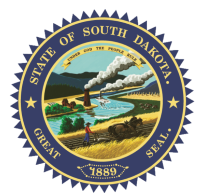 The original design of the Great Seal of South Dakota, along with the motto "Under God the People Rule", was first suggested by Dr. Joseph Ward, the founder of Yankton College. At the conclusion of the Constitutional Convention of 1885 the ultimate design and motto were adopted and then modified in 1889 in Article XXI, Miscellaneous, Section 1, of the Original State Constitution, which reads:
The original design of the Great Seal of South Dakota, along with the motto "Under God the People Rule", was first suggested by Dr. Joseph Ward, the founder of Yankton College. At the conclusion of the Constitutional Convention of 1885 the ultimate design and motto were adopted and then modified in 1889 in Article XXI, Miscellaneous, Section 1, of the Original State Constitution, which reads:
Seal and Coat of Arms. The design of the Great Seal of Dakota shall be as follows: A circle within which shall appear in the left foreground, a smelting furnace and other features of mining work. In the left background, a range of hills. In the right foreground, a farmer at his plow. In the right background, a herd of cattle and a field of corn. Between the two parts thus described shall appear a river bearing a steamboat. Properly divided between the upper and lower edges of the circle shall appear the legend, "Under God the People Rule," which shall be the motto of the State of South Dakota. Exterior to this circle and within a circumscribed circle shall appear in the upper part the words "State of Dakota," in the lower part the words "Great Seal" and the date in Arabic numerals of the year in which the state shall be admitted to the Union.
It is noted that this adoption occurred four years prior to South Dakota being admitted
as a state. The wording from 1885 was changed from "State of Dakota" to "State of South Dakota" in 1889.
The color interpretation of the Great Seal was not standardized until a Mitchell, SD, artist, Richard Cropp, designed the official color version in magic marker as the basis for all reproductions. This version was later revised by John Moisan from Fort Pierre, who was commissioned by Governor Bill Janklow in 1986, to create an official painted version from which all future replications are now based. In January 2016, John G. Moisan penned the following letter, documenting his memories of the State Seal.
In 1982, I transferred from the Department of Public Safety to the Bureau of Administration by, then Governor, Bill Janklow to be a forms management specialist. My job was to consolidate state forms and reduce the number and quantity of forms used by state government and to, somehow, cause agencies to share information, rather than each collecting their own data. My "first" job, however, quickly changed as the Governor found [out] about my artistic ability and directed me to paint a colored version of the South Dakota State Seal for his office.
In my research, I found the "official" South Dakota State Seal in the Secretary of State's vault in the basement of the Capitol. The "official" state seal was a black and white drawing colored with magic marker that had faded to white over time. That seal was listed in SDCL and included the artist's name and specifications. The seal in the vault was on white paper glued to a piece of foam core board and in very poor condition. I returned the seal to the vault and never used it.
After I described the situation to Governor Janklow, he directed me to paint a new official state seal that would be hung in his office. I assumed that he had coordinated with the Secretary of State at the time.
I set about, then, to recreate the new state seal for the Governor's Office. Over a period of about 8 weeks, I painted the new official state seal using acrylic paint on acid free board using the descriptions of color and panorama of the State Seal described in SDCL. The completed seal was then permanently glued to a mahogany frame and hung behind Governor Janklow's desk. Once the State Seal was hung in the Governor's Office, SDCL was changed to reflect the official changes:
1-6-1. State seal adopted--Reproductions. There is hereby adopted as the official colored seal of the State of South Dakota, a reproduction of the seal, described in article XXI, section 1 of the Constitution of the State of South Dakota, and made in conformity therewith but whose proportions and colored detail are set out specifically in accord with an original painting of the great seal produced by John G. Moisan of Fort Pierre and shall be the basis for all reproductions of the great seal of the State of South Dakota.
At one point, I rescued that very same State Seal from going to surplus property from a Governor's staff person because "the Governor didn't like it" and it was rehung behind the Governor's desk. I assume it is still there today. Since then, the version of the State Seal which hangs behind the Governor's desk has been the basis for all state seal duplications, as well as the reproductions of the South Dakota State Flag. To my knowledge, there is no notification on the State Seal that it is the "Official" State Seal.
The Official State Seal was transferred from State Archives to the Secretary of State's Office in January 2017, where it is on public display in the lobby.
For information regarding the Application Request
for One-Time Use of the State Seal - click here.
State Flag and Pledge
The current, official South Dakota State Flag features the state seal surrounded by a golden blazing sun in a field of sky blue. Letters reading "South Dakota, The Mount Rushmore State" - the official state nickname are arranged in a circle around the sun. However, the original flag or banner had a different design.
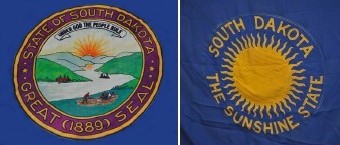
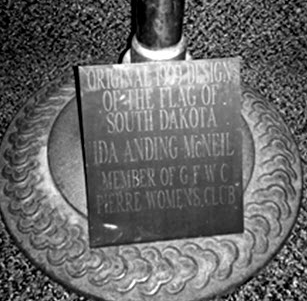
South Dakota had no official state flag until 1909. As recounted in Wiiyohi Bulletin, Volume II, November 1, 1948: "In 1909 Senator Ernest May of Deadwood came into the Historical Society office. Seth Bullock wanted a state flag. May asked Doane Robinson about it and was told by Robinson that Ida Anding, now Mrs. McNeil, former operator of KGFX radio of Pierre, who was then a stenographer in the Historical offices, would design him a flag. She did. It was a blazing sun, on an azure (blue) background. May liked the design, Senate Bill 208 was introduced. Later on the floor, he moved that 'on the reverse of the blazing sun shall appear the Great Seal of the State of South Dakota in dark blue.' This was adopted and the bill passed. Money to buy two flags was appropriated. One went to the Secretary of State, and Seth Bullock of Camp No. 1, United Spanish Veterans of South Dakota, got the other."
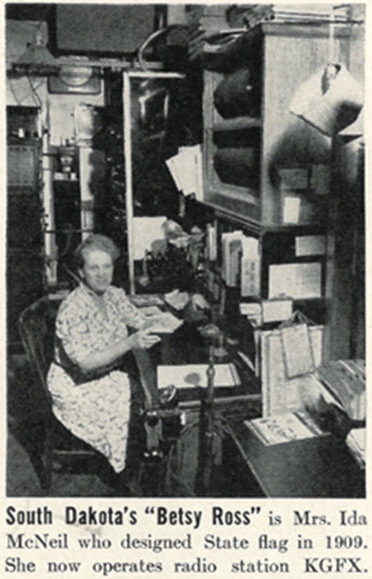
The state flag was then designed by Ida M. Anding, legislative librarian, in 1909, according to the following specifications: "The Flag of South Dakota shall consist of a field of blue, one and two-thirds as long as it is wide, in the center of which shall be a blazing sun in gold, two-fifths as wide in diameter as the width of the flag. Above this sun shall be arranged in the arc of the circle, in gold letters, the words 'South Dakota' and below this sun in the arc of the circle shall be arranged the words in gold letters, 'The Sunshine State', and on the reverse of the blazing sun shall be printed in dark blue the Great Seal of the State of South Dakota. The edges of the flag shall be trimmed with a fringe of gold, to be in proportion to the width of the flag. The staff shall be surmounted by a spearhead to which shall be attached cord and tassels of suitable length and size."
This was the only official state flag until the year 1963. It became increasingly evident by this time that the cost to manufacture a flag with a different emblem on each side was expensive to the degree that there were few South Dakota state flags in existence, and they were seldom flown. In the legislature of 1963, House Bill 503, introduced by Representative William Sahr of Hughes County, was enacted and approved by the Governor on March 11, 1963.
It appears this was a wise decision, as the cost of the South Dakota state flag was greatly reduced, and more requests for the state flag were made than ever before. In 1992, a measure sponsored by State Representative Gordon Pederson of Pennington County, South Dakota, changed the wording on the flag to read "The Mount Rushmore State". Codified law now reads as follows:
§1-6-4. State flag - Description. The state flag or banner shall consist of a field of sky-blue one and two-thirds as long as it is wide. Centered on such field shall be the great seal of South Dakota made in conformity with the terms of the Constitution, which shall be four-ninths, the width of the flag in diameter. The seal shall be on a white background with the seal outlined in dark blue or, in the alternative, shall be on a sky-blue background with the seal outlined in dark blue thereon. Surrounding the seal in gold shall be a serrated sun whose extreme width shall be five-ninths the width of the flag. The words "South Dakota" symmetrically arranged to conform to the circle of the sun and seal shall appear in gold letters one-eighteenth the width of the field above the sun and seal and the words "The Mount Rushmore State" in like-sized gold letters and in like arrangement shall appear below the sun and seal. Flags designed of such material as may be provident for outdoor use need have no fringe but flags for indoor and display usage shall have a golden fringe one-eighteenth the width of the flag on the three sides other than the hoist.
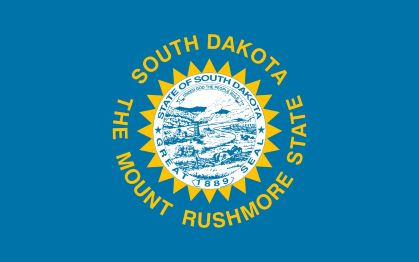
Of the two Original State Flags that were appropriated and made, one is maintained by State Archives at the Cultural Heritage Center. The other Official 1909 State Flag was placed back on public display in the Secretary of State's Office in October 2015.
The Official Pledge to the State Flag is:
"I pledge loyalty and support to the flag and state of
South Dakota, land of sunshine, land of infinite variety."
The pledge to the flag and to the state may not preempt, replace, or be recited before the pledge of allegiance to the flag of the United States.
State Song: "Hail South Dakota"
The official state song was adopted in 1943. It is a marching song, composed by Deecort Hammitt.
View "Hail South Dakota" sheet music
State Animal: Coyote (canis latrans)
 Named the state animal in 1949, the coyote is a natural and adaptable predator of small game and rodents, hunting the open prairies and fields over the entire state. The coyote occurs in greatest numbers along the Missouri River, its tributaries, and in the Black Hills. The coyote appears often in the traditions and tales of Native Americans, usually as a very savvy and clever beast.
Named the state animal in 1949, the coyote is a natural and adaptable predator of small game and rodents, hunting the open prairies and fields over the entire state. The coyote occurs in greatest numbers along the Missouri River, its tributaries, and in the Black Hills. The coyote appears often in the traditions and tales of Native Americans, usually as a very savvy and clever beast.
State Bird: Ring-Neck Pheasant (phasianus colchicus)
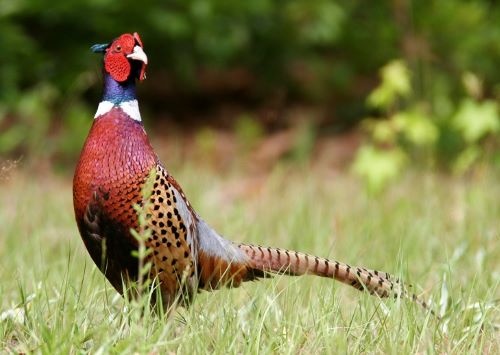 Native to Asia, the Ring-Necked Pheasant was first successfully introduced to Spink County, South Dakota in 1908 by A.E. Cooper and E.L. Ebbert. Easily recognized by its colorful plumage, the pheasant is also known for its delicious meat. Since it is primarily a Midwestern bird, pheasant is considered a delicacy in many states. The Ring-Neck Pheasant officially earned the state bird designation in 1943.
Native to Asia, the Ring-Necked Pheasant was first successfully introduced to Spink County, South Dakota in 1908 by A.E. Cooper and E.L. Ebbert. Easily recognized by its colorful plumage, the pheasant is also known for its delicious meat. Since it is primarily a Midwestern bird, pheasant is considered a delicacy in many states. The Ring-Neck Pheasant officially earned the state bird designation in 1943.
State Soil: Houdek Soil
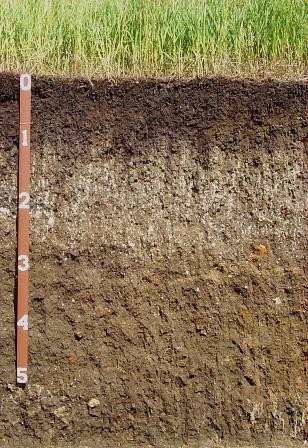 Houdek was designated the state soil in 1990. According to the United States Department of Agriculture:
Houdek was designated the state soil in 1990. According to the United States Department of Agriculture:
Houdek soil, a deep, well drained, loamy soil, represents many soils formed in South Dakota under the influence of prairie grass. The surface layer is dark colored from decayed plants and other material that has been deposited over thousands of years.
Houdek soil is of major economic importance to South Dakota because the productive Houdek soils are often used for cropland and rangeland. Small grains, corn, sunflowers, and soybeans are commonly grown crops. Alfalfa and grass-alfalfa mixtures provide hay and pasture for grazing livestock. Large areas of Houdek soil are in native range. Crops and grasses grown on the Houdek soil also provide habitat for wildlife.
State Drink: Milk (lac vacuum)
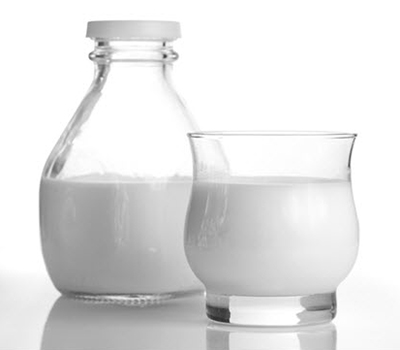 Dairy producers are one of the major industries in South Dakota, producing nearly 246 million gallons of milk in 2014 and generating approximately $427 million in sales annually. Milk was adopted as the official state drink in 1986.
Dairy producers are one of the major industries in South Dakota, producing nearly 246 million gallons of milk in 2014 and generating approximately $427 million in sales annually. Milk was adopted as the official state drink in 1986.
State Insect: Honey Bee (apis mellifera L)
 South Dakota is a leader in honey production. In recognition of its importance to the state's farm economy, the honey bee was adopted as the state insect in 1978. The state's mild, clear, clover honey is often shipped out-of-state to be blended with darker honey.
South Dakota is a leader in honey production. In recognition of its importance to the state's farm economy, the honey bee was adopted as the state insect in 1978. The state's mild, clear, clover honey is often shipped out-of-state to be blended with darker honey.
State Fossil: Triceratops
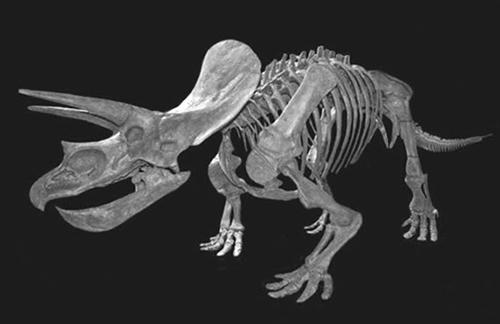 A horned dinosaur of the late Cretaceous period (about 66 to 68 million years ago) is the state fossil. The Triceratops was an herbivorous ceratopsid (quadrupedal), who may have used its horns and frill for combat or display in courtship. Discovered in Harding County in 1927, the skeleton is now on display in Rapid City at the Museum of Geology, South Dakota School of Mines and Technology.
A horned dinosaur of the late Cretaceous period (about 66 to 68 million years ago) is the state fossil. The Triceratops was an herbivorous ceratopsid (quadrupedal), who may have used its horns and frill for combat or display in courtship. Discovered in Harding County in 1927, the skeleton is now on display in Rapid City at the Museum of Geology, South Dakota School of Mines and Technology.
State Grass: Western Wheatgrass (pascopyrum/agropyron smithii)
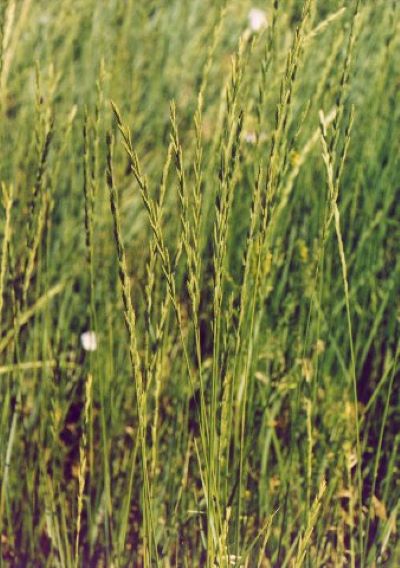 This variety of wheat is a common grass that is one of the few found throughout South Dakota. It is a long lived, cool season species that has coarse blue-green leaves with prominent veins. Because of this bluish appearance, it has sometimes been called bluestem wheatgrass or blue-joint. The sheaths are hairy and the purplish auricles typically clasp the stem. It is grown primarily as feed for livestock and harvested for its seed. Western Wheatgrass was named the state grass in 1970.
This variety of wheat is a common grass that is one of the few found throughout South Dakota. It is a long lived, cool season species that has coarse blue-green leaves with prominent veins. Because of this bluish appearance, it has sometimes been called bluestem wheatgrass or blue-joint. The sheaths are hairy and the purplish auricles typically clasp the stem. It is grown primarily as feed for livestock and harvested for its seed. Western Wheatgrass was named the state grass in 1970.
State Flower: American Pasque
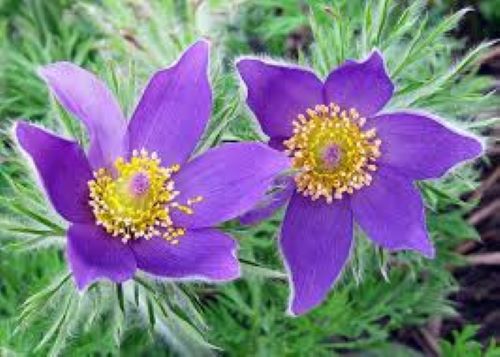 Also called the May Day flower, the American Pasque grows wild throughout the state. In 1903, South Dakota law set forth that "the floral emblem of this state shall be the American pasque flower (pulsatilla hirsutissima) with the motto 'I lead.'" South Dakota is the only state which has an emblem with a motto instead of simply a flower.
Also called the May Day flower, the American Pasque grows wild throughout the state. In 1903, South Dakota law set forth that "the floral emblem of this state shall be the American pasque flower (pulsatilla hirsutissima) with the motto 'I lead.'" South Dakota is the only state which has an emblem with a motto instead of simply a flower.
The blooming of this lavender flower is one of the first signs of spring in South Dakota.
State Jewelry: Black Hills Gold
 Black Hills Gold jewelry was first created in the 1870s by French goldsmith Henri LeBeau. Today, this beautiful jewelry is created and manufactured exclusively in the Black Hills. Each design incorporates the motif of grape clusters and leaves in tricolor combinations of green, rose, and yellow gold, making it easily recognizable. The state jewelry was designated in 1988.
Black Hills Gold jewelry was first created in the 1870s by French goldsmith Henri LeBeau. Today, this beautiful jewelry is created and manufactured exclusively in the Black Hills. Each design incorporates the motif of grape clusters and leaves in tricolor combinations of green, rose, and yellow gold, making it easily recognizable. The state jewelry was designated in 1988.
State Gemstone: Fairburn Agate
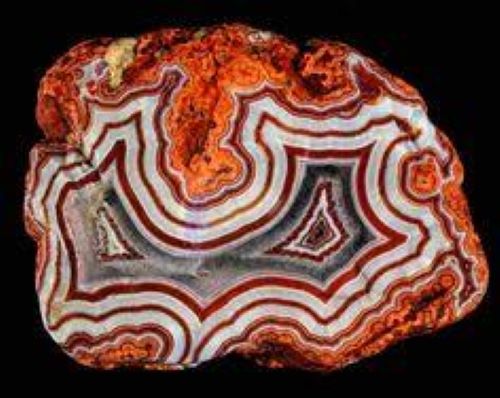 Fairburn Agate is a semiprecious stone that was first discovered near Fairburn, South Dakota. Found primarily in an area extending from Orella, Nebraska, to Farmingdale, South Dakota, it is used in jewelry and is a favorite of rock collectors. Fairburn agates are noted for their strikingly contrasted, thin bands of natural colors; generally yellowish-brown with narrow opaque white bands, or dark red with white bands. This designation was made in 1966.
Fairburn Agate is a semiprecious stone that was first discovered near Fairburn, South Dakota. Found primarily in an area extending from Orella, Nebraska, to Farmingdale, South Dakota, it is used in jewelry and is a favorite of rock collectors. Fairburn agates are noted for their strikingly contrasted, thin bands of natural colors; generally yellowish-brown with narrow opaque white bands, or dark red with white bands. This designation was made in 1966.
State Mineral: Rose Quartz
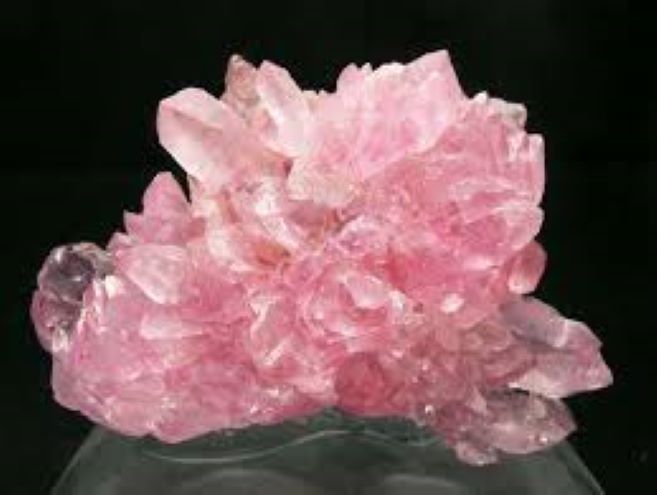 This pink colored quartz was discovered near Custer, South Dakota, in the 1880s. It is mined in the southern Black Hills and is used primarily for ornaments and jewelry. In South Dakota, the color of rose quartz ranges from the pale shades of pink to rose-pink to rose-red. Occasionally, it has a faint purplish or lavender cast. This designation was made in 1966.
This pink colored quartz was discovered near Custer, South Dakota, in the 1880s. It is mined in the southern Black Hills and is used primarily for ornaments and jewelry. In South Dakota, the color of rose quartz ranges from the pale shades of pink to rose-pink to rose-red. Occasionally, it has a faint purplish or lavender cast. This designation was made in 1966.
State Nickname: The Mount Rushmore State
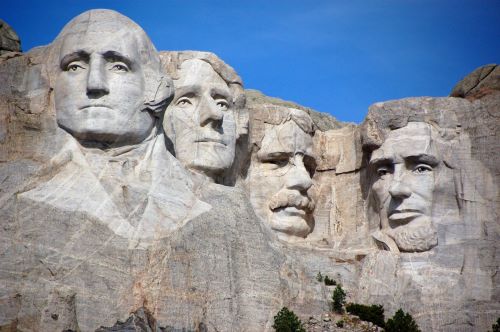 The state nickname became official in 1992. The Mount Rushmore State refers to the mountain sculpture created by Gutzon Borglum over a period of 14 years. Before that South Dakota was known as the "Sunshine State", the "Coyote State", the "Artesian State", the "Blizzard State", "The Land of Plenty", and "The Land of Infinite Variety."
The state nickname became official in 1992. The Mount Rushmore State refers to the mountain sculpture created by Gutzon Borglum over a period of 14 years. Before that South Dakota was known as the "Sunshine State", the "Coyote State", the "Artesian State", the "Blizzard State", "The Land of Plenty", and "The Land of Infinite Variety."
State Fish: Walleye (stizostedion vitreum)
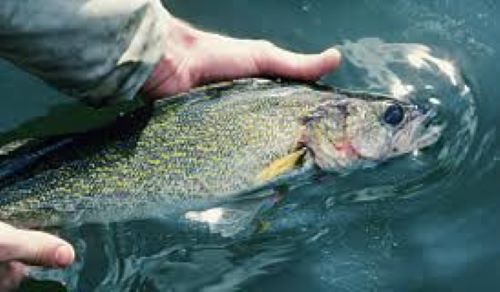 Designated as the state fish in 1992, the walleye is the fish most sought after by South Dakota anglers, not only because it is one of the most challenging adversaries but also because of its delicious and delicate taste. Found in lakes and rivers across the state, walleye is most common in the Missouri River system and the glacial lakes area of northeastern South Dakota. The Museum of Wildlife, Science, and Industry, located in the city of Webster, is designated as the site of the official State Fishing Museum.
Designated as the state fish in 1992, the walleye is the fish most sought after by South Dakota anglers, not only because it is one of the most challenging adversaries but also because of its delicious and delicate taste. Found in lakes and rivers across the state, walleye is most common in the Missouri River system and the glacial lakes area of northeastern South Dakota. The Museum of Wildlife, Science, and Industry, located in the city of Webster, is designated as the site of the official State Fishing Museum.
State Musical Instrument: Fiddle
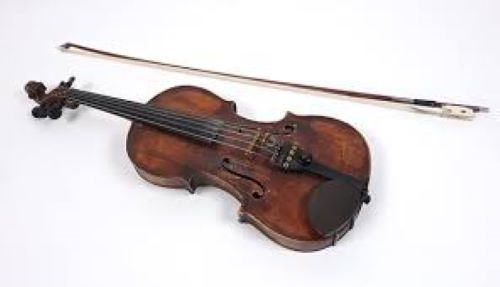 The fiddle was designated the official state musical instrument in 1989. Fiddle is another name for the bowed string musical instrument more often called a violin. It is also a colloquial term for the instrument used by players in all genres, including classical music. Fiddle is also a common term among musicians who play folk music on the violin. Wilbur Foss, a Scotland, South Dakota, native, organized the South Dakota Old Time Fiddlers Association. The association has been in existence for over thirty years.
The fiddle was designated the official state musical instrument in 1989. Fiddle is another name for the bowed string musical instrument more often called a violin. It is also a colloquial term for the instrument used by players in all genres, including classical music. Fiddle is also a common term among musicians who play folk music on the violin. Wilbur Foss, a Scotland, South Dakota, native, organized the South Dakota Old Time Fiddlers Association. The association has been in existence for over thirty years.
State Tree: Black Hills Spruce (picea glauca densata)
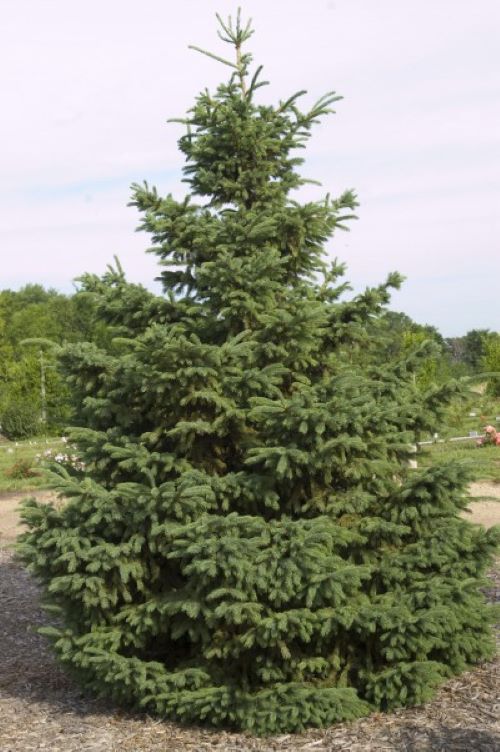 The Black Hills Spruce, named in 1947, as the state tree, is a member of the evergreen family. Black Hills Spruce is a naturally occurring variety of white spruce native to South Dakota. The pyramid shaped tree is characterized by dense foliage of short, blue-green needles and slender cones. The largest spruce tree is 95 feet tall with a canopy spread of 42 feet. The Black Hills Spruce is very wind firm, not damaged by heavy snow or ice storms, and can live 80 or more years in windbreaks. Deer will normally not eat this species unless nothing else is available.
The Black Hills Spruce, named in 1947, as the state tree, is a member of the evergreen family. Black Hills Spruce is a naturally occurring variety of white spruce native to South Dakota. The pyramid shaped tree is characterized by dense foliage of short, blue-green needles and slender cones. The largest spruce tree is 95 feet tall with a canopy spread of 42 feet. The Black Hills Spruce is very wind firm, not damaged by heavy snow or ice storms, and can live 80 or more years in windbreaks. Deer will normally not eat this species unless nothing else is available.
State Dessert: Kuchen
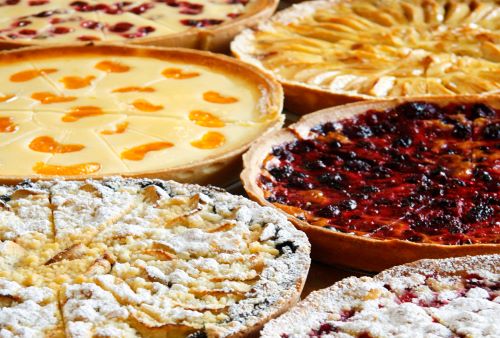 This quintessential German Russian pastry is a sweet dough crust filled with custard, which is served plain or studded with fruit, such as prunes, peaches, blueberries, and apples. Kuchen was designated as the official state dessert in 2000.
This quintessential German Russian pastry is a sweet dough crust filled with custard, which is served plain or studded with fruit, such as prunes, peaches, blueberries, and apples. Kuchen was designated as the official state dessert in 2000.
Try this recipe for Apple Kuchen and taste for yourself!
-
For the crust:
- 2 cups flour
- ½ cup sugar
- ¼ teaspoon kosher salt
- ½ teaspoon vanilla extract
- ½ pound (2 sticks) unsalted butter, cold and cut into pieces
-
For the filling:
- 1 pound cream cheese, at room temperature
- ¾ cup sugar
- 1 teaspoon vanilla extract
- 1 egg, at room temperature
-
For the topping:
- 2 tablespoons sugar
- 1½ teaspoons ground cinnamon
- 3 Granny Smith apples, peeled, if desired, cored, and thinly sliced
Preheat the oven to 450 degrees. Lightly grease and flour a 9x13 inch pan.
Place the flour, sugar, and salt in a large bowl or food processor (fitted with a steel blade) and mix to combine. Add the vanilla and butter, a little at a time. Press into the baking pan and bake in an oven until slightly golden but not brown, about 12 to 15 minutes. Cool. Then lower the oven temperature to 350 degrees.
To make the filling, mix the cream cheese, sugar, and vanilla in mixer (preferably with a paddle) and beat until creamy. Add the egg. Mix to combine and pour over the cooled crust.
Place the sugar and cinnamon in a small bowl and mix to combine. Place the fruit on top of the filling in two or three columns. Sprinkle with the cinnamon sugar and transfer to the oven. Bake about 30 to 40 minutes until golden brown and firm. Cut into 20 to 24 pieces.
State Sport: Rodeo
Rodeos are rooted in South Dakota history, as people across the state gather to both watch and participate. They are a time honored tradition throughout the state. Rodeos are generally comprised of the following events: tie-down roping, team roping, steer wrestling, saddle bronc riding, bareback bronc riding, bull riding, and barrel racing. These events are divided into two basic categories: the rough stock events and the timed events. Rodeo became the official sport of the State of South Dakota in 2003.
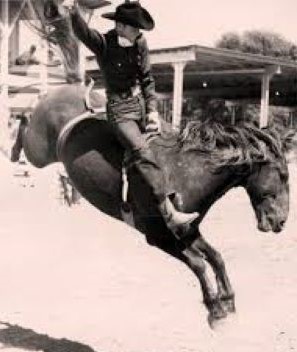
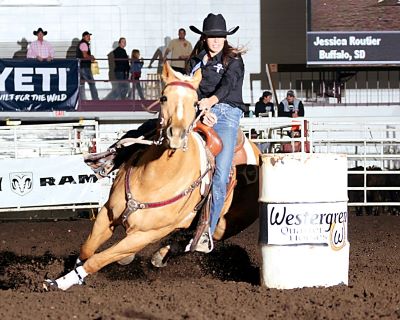
State Bread: Frybread
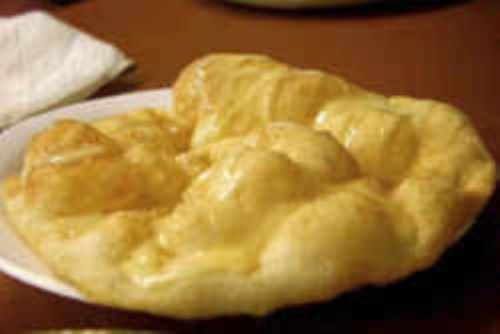 Frybread has been part of Native American family meals for generations. A mixture of flour, sugar, salt and oil, the dough is then fried in hot oil. Frybread is served both at home and public events, such as fairs and pow wows. With House Bill 1205, the 2005 Legislature designated fry bread as the official bread of South Dakota.
Frybread has been part of Native American family meals for generations. A mixture of flour, sugar, salt and oil, the dough is then fried in hot oil. Frybread is served both at home and public events, such as fairs and pow wows. With House Bill 1205, the 2005 Legislature designated fry bread as the official bread of South Dakota.
